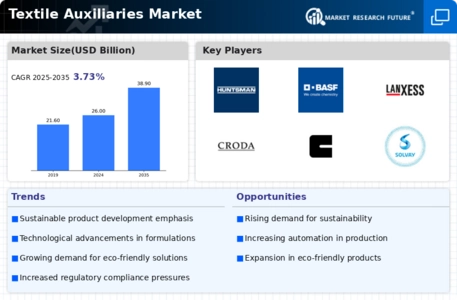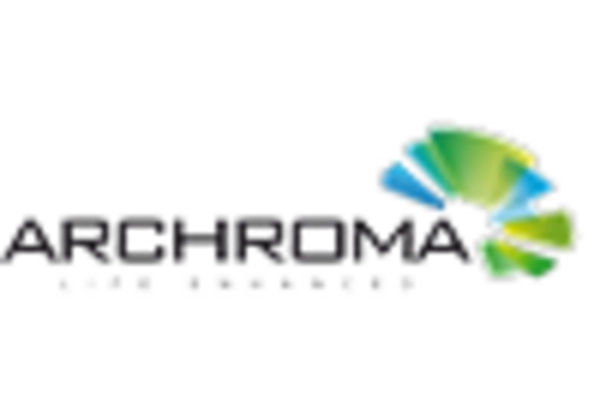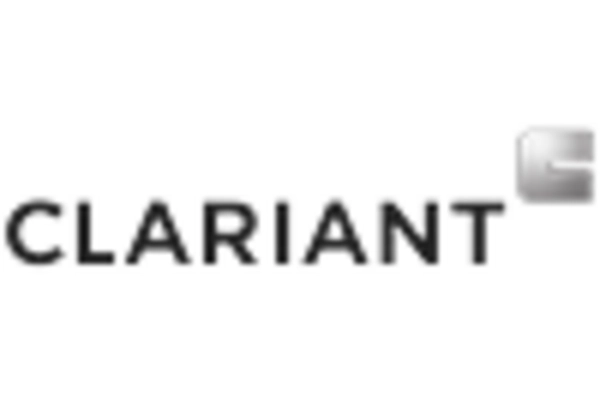Regulatory Standards and Compliance
Regulatory compliance is an essential driver in the Textile Auxiliaries Market. Governments and international bodies are increasingly implementing stringent regulations regarding the use of chemicals in textile production. These regulations aim to ensure consumer safety and environmental protection. As a result, manufacturers are compelled to invest in compliant textile auxiliaries that meet these standards. The market for compliant auxiliaries is expected to grow as companies seek to avoid penalties and enhance their brand reputation. This trend indicates a shift towards more responsible manufacturing practices within the Textile Auxiliaries Market, potentially leading to a more sustainable future.
Rising Demand for Eco-Friendly Products
The increasing consumer preference for sustainable and eco-friendly products is a pivotal driver in the Textile Auxiliaries Market. As awareness regarding environmental issues grows, manufacturers are compelled to adopt greener practices. This shift is reflected in the rising demand for biodegradable and non-toxic textile auxiliaries. According to recent estimates, the market for eco-friendly textile auxiliaries is projected to grow at a compound annual growth rate of approximately 8% over the next five years. This trend not only aligns with consumer expectations but also encourages innovation in product development, leading to a broader range of sustainable options in the Textile Auxiliaries Market.
Emerging Markets and Global Trade Dynamics
Emerging markets are becoming increasingly influential in the Textile Auxiliaries Market. Countries in Asia, Africa, and Latin America are witnessing rapid industrialization and urbanization, leading to heightened demand for textiles. This growth is further fueled by global trade dynamics, which facilitate the exchange of textile products and auxiliaries across borders. As these markets expand, the need for effective textile auxiliaries that enhance product quality and performance is likely to increase. Analysts suggest that the market in these regions could grow at a rate of 7% annually, reflecting the potential for significant opportunities within the Textile Auxiliaries Market.
Growth of the Apparel and Fashion Industry
The expansion of the apparel and fashion industry significantly influences the Textile Auxiliaries Market. As fashion trends evolve and consumer preferences shift, the demand for diverse textile products increases. This growth is particularly evident in emerging markets, where rising disposable incomes are driving consumption. The apparel sector's need for specialized textile auxiliaries, such as softeners, anti-wrinkle agents, and colorants, is expected to surge. Market analysts project that the textile auxiliaries segment catering to the fashion industry could experience a growth rate of around 6% annually over the next few years. This trend highlights the interdependence between the fashion industry and the Textile Auxiliaries Market.
Technological Innovations in Textile Processing
Technological advancements play a crucial role in shaping the Textile Auxiliaries Market. Innovations such as digital printing, nanotechnology, and automation are enhancing the efficiency and effectiveness of textile processing. These technologies enable manufacturers to produce high-quality textiles with reduced resource consumption. For instance, the integration of smart textiles and advanced dyeing techniques is expected to increase the demand for specialized auxiliaries. The market for textile auxiliaries that support these technologies is anticipated to witness substantial growth, potentially reaching a valuation of several billion dollars by 2026. This evolution underscores the importance of staying abreast of technological trends within the Textile Auxiliaries Market.


















Leave a Comment